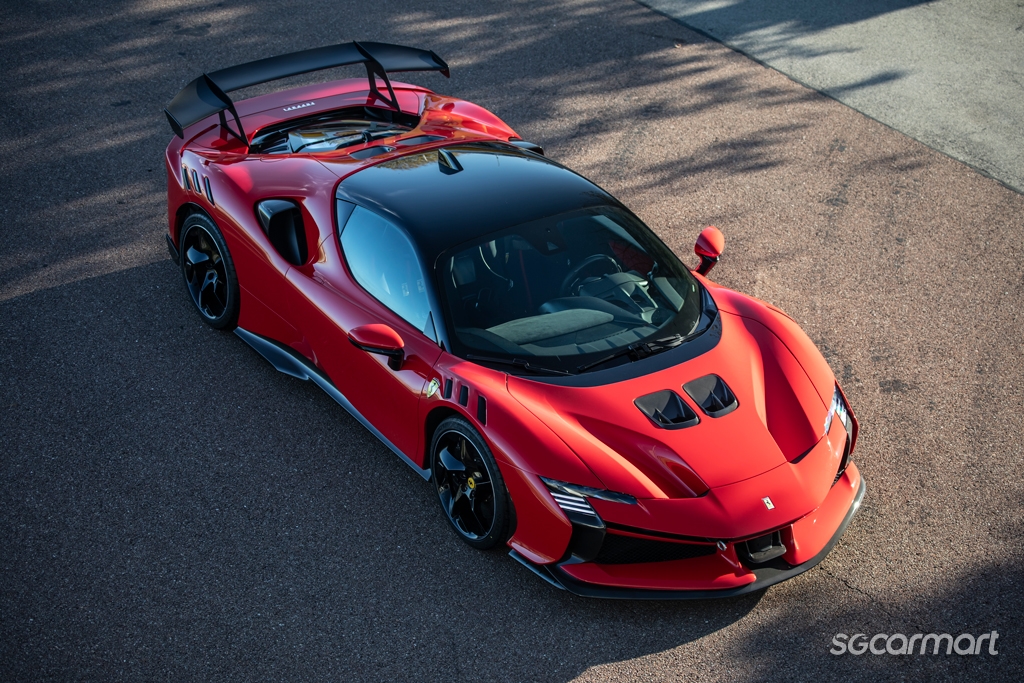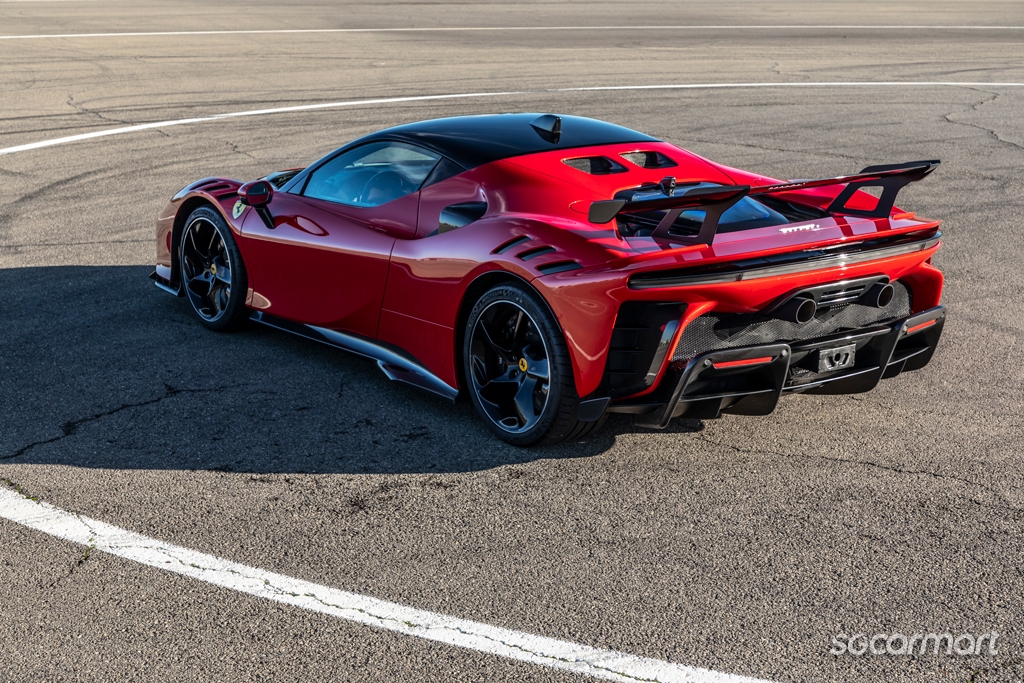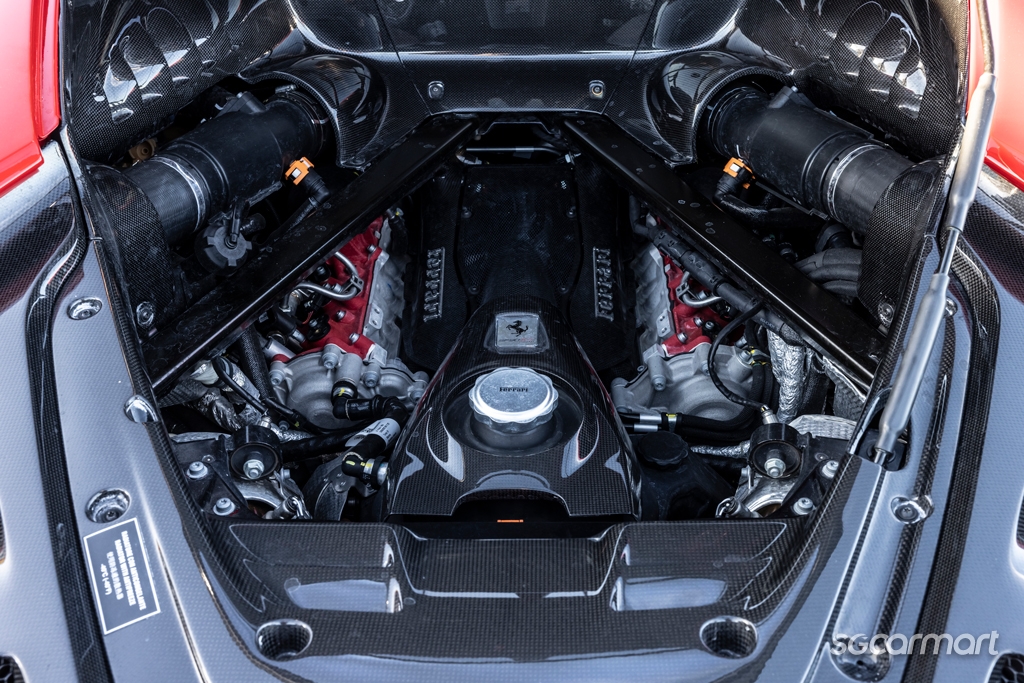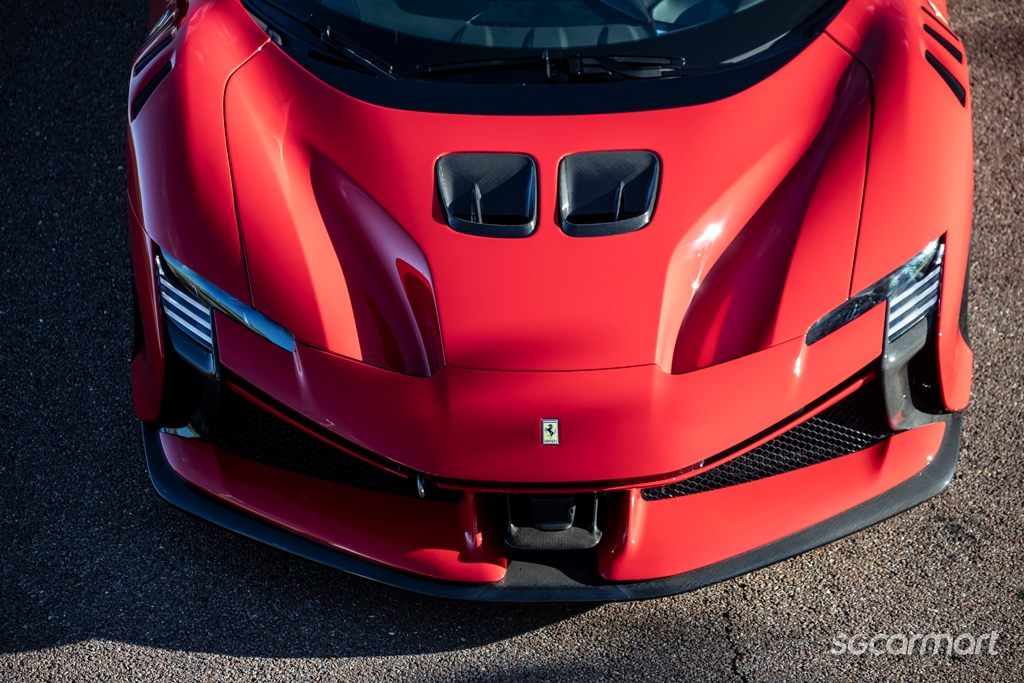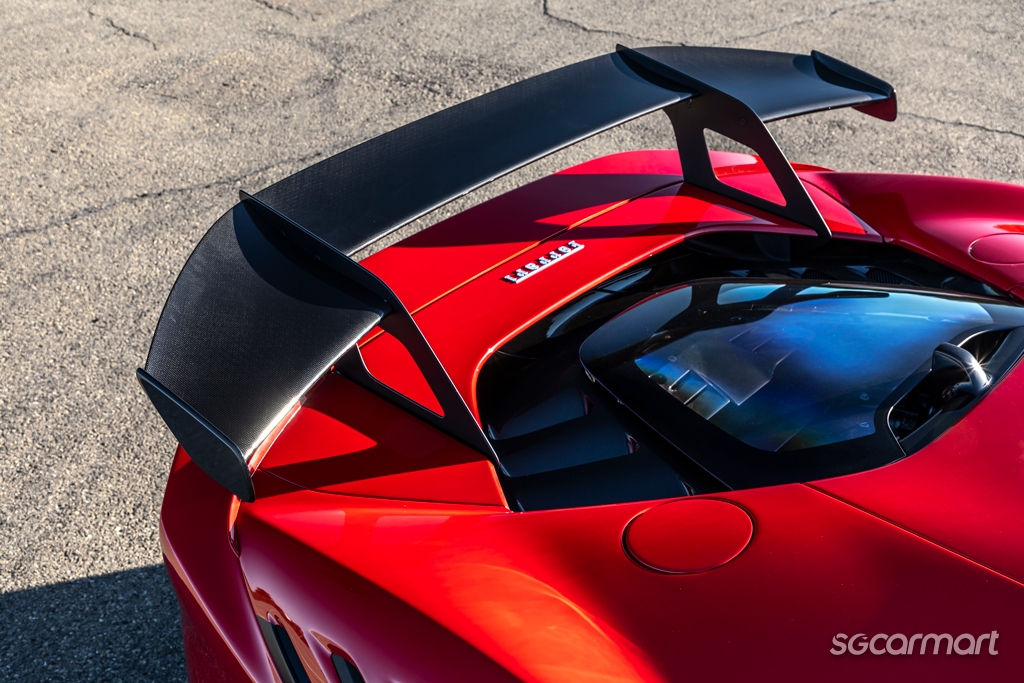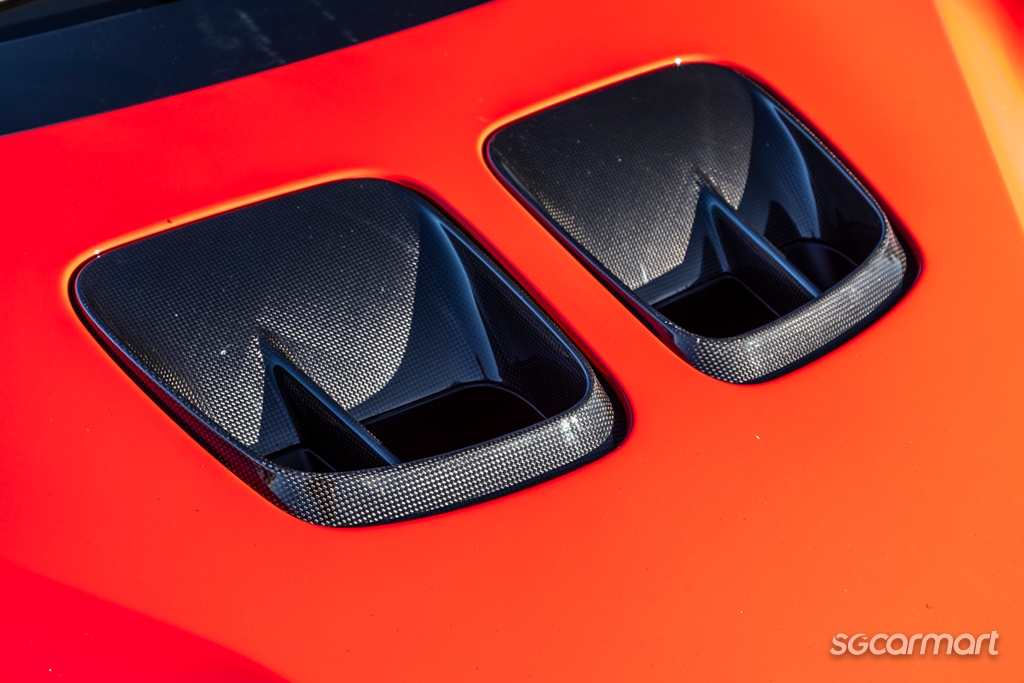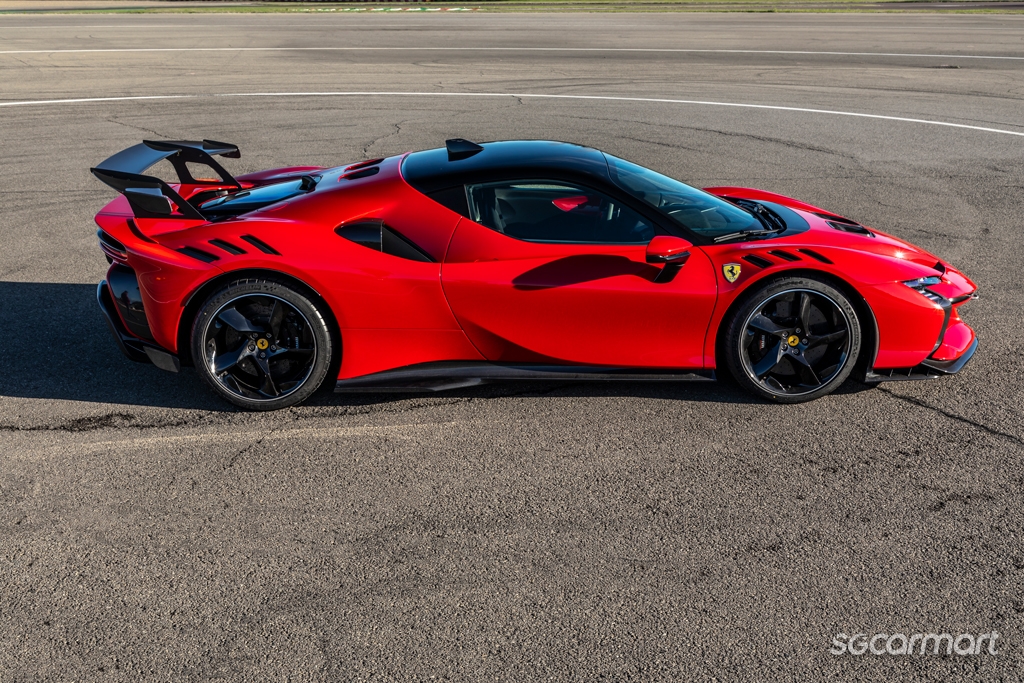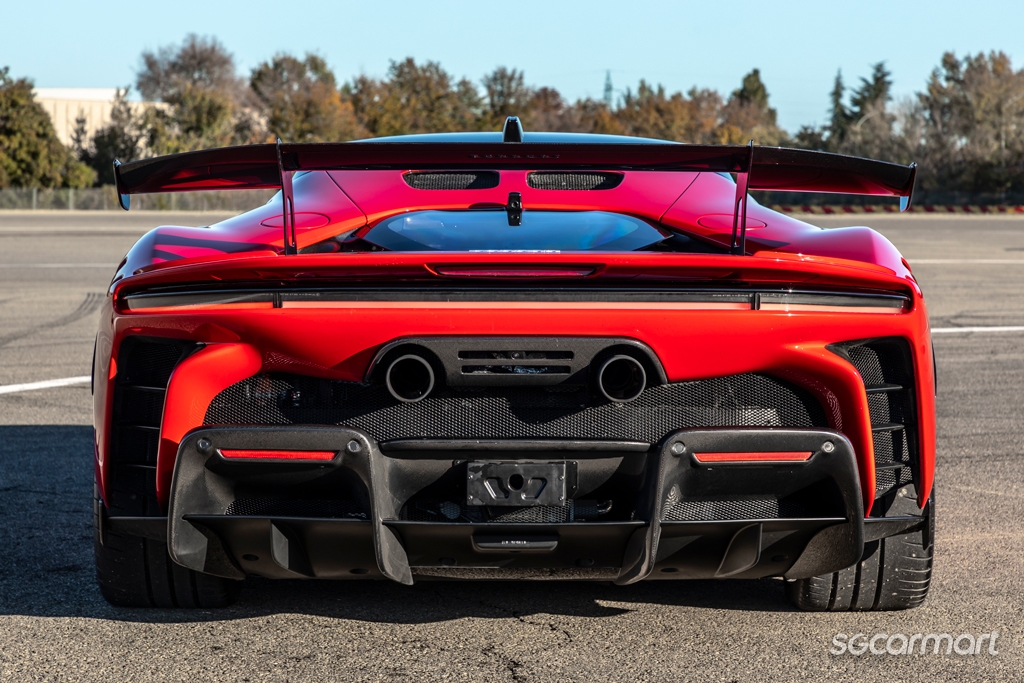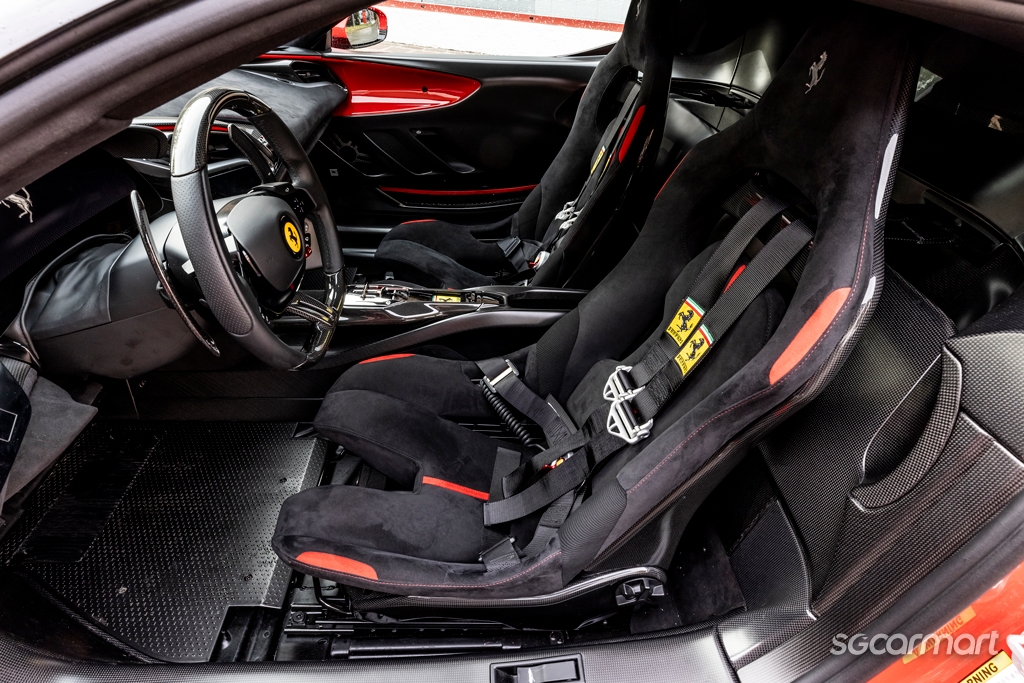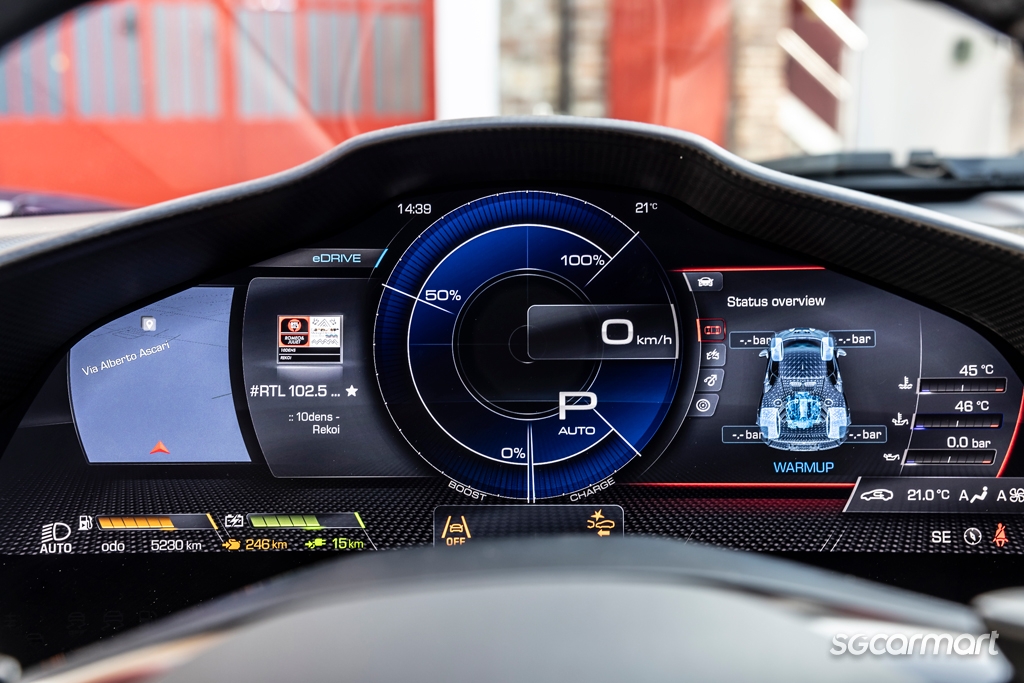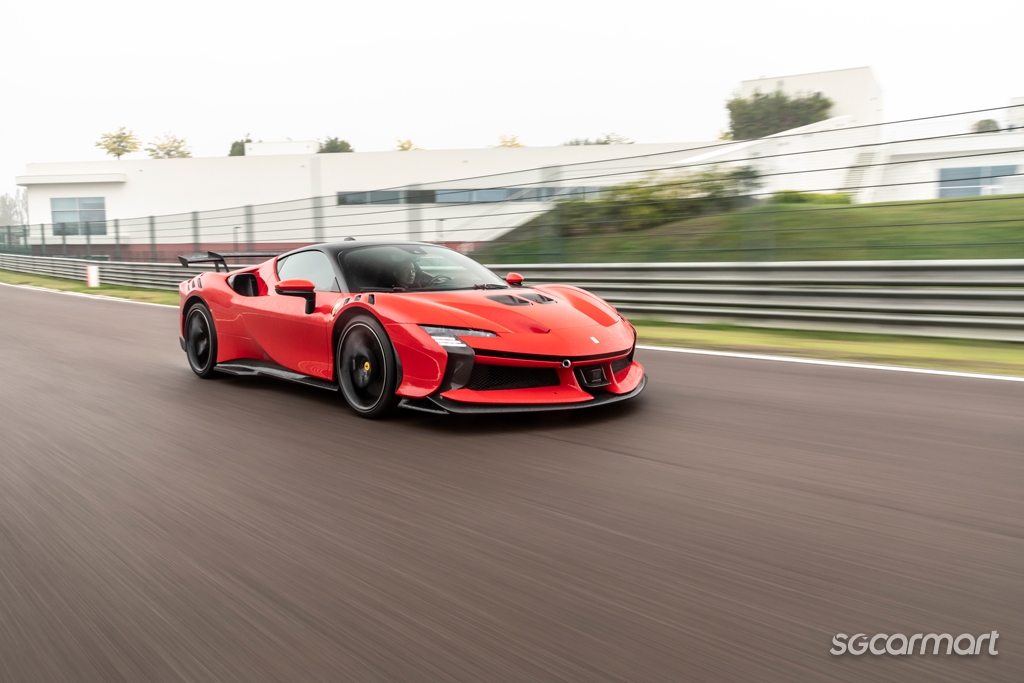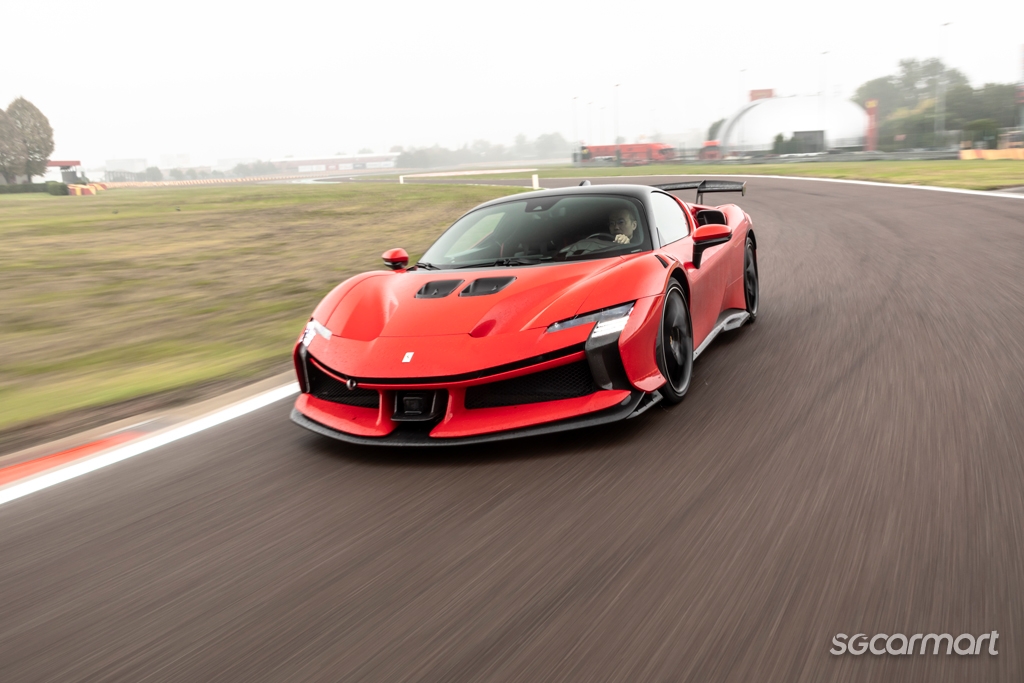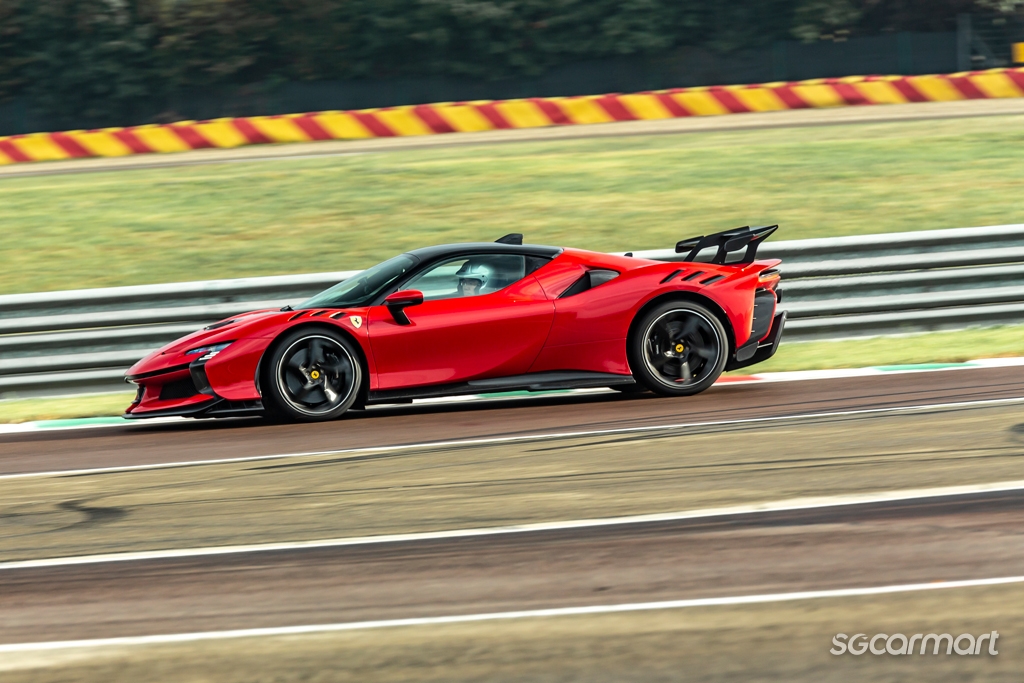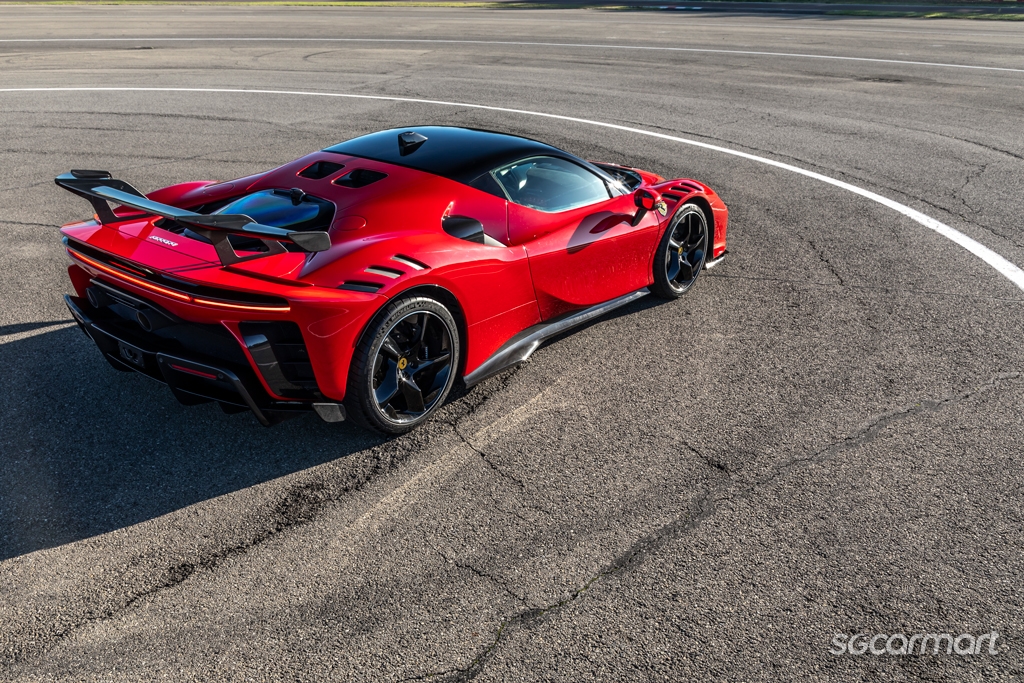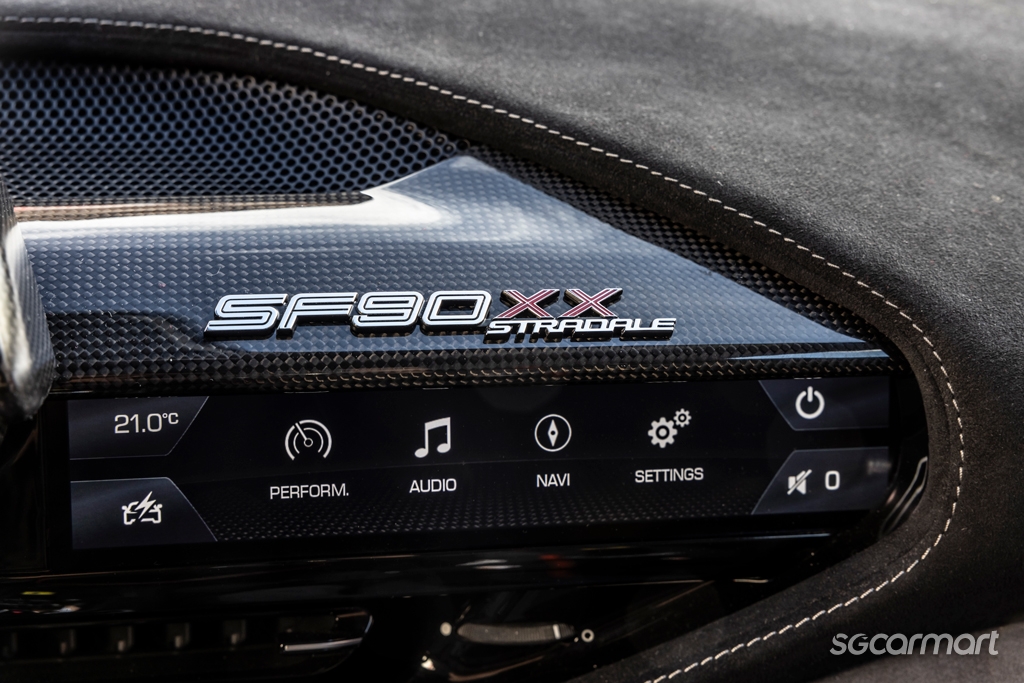Ferrari SF90 XX Stradale First Drive Review
18 Nov 2023|3,683 views
What We Like
Mind-boggling power
Stupendous performance
Also offers electric-only driving
Mighty brakes
What We Dislike
Eye-popping price tag
Requires a racetrack to run
Nerves are fairly typical when you're waiting to test a new car on track; outright terror, not so much. But when the beast that they're strapping you into has 1030hp and the track is glistening sinisterly from a relentless drizzle, it's time to be afraid. Very afraid.
The beast in question, the Ferrari SF90 XX Stradale, is the latest and most powerful-ever road car from the fabled Italian brand. It costs over S$4 million on the road in Singapore, and will hit 100km/h from standstill in 2.3 seconds and 200km/h just 4.2 seconds later. Assuming I can keep it on track.
It is the latest in the line of Ferrari's "Special Series" cars like the 430 Scuderia, 458 Speciale and 812 Competizione - all extreme, mutant versions of cars from Ferrari's standard range. But the SF90 XX is the first that's based on a Ferrari supercar (the plug-in hybrid SF90), as opposed to one of its "regular" V8 and V12 models.
Italian stallions
Its name is an obvious nod to the stripped-out "XX Programme" track-only cars such as the Enzo-based FXX and FXX Evo, the 599XX and 599XX Evo, and the LaFerrari-derived FXX K and FXX-K Evo.
Ferrari sells these XX cars, by invite only, to select long-time customers for use exclusively at track days, with full factory support at each event - and also to use as a technological testbed. Being a road car, the SF90 XX is not itself an XX Programme car, but it draws massively from XX Programme-developed technology.
It is ultra-exclusive too. Only 799 units of this car (and 599 units of its topless twin the SF90 XX Spider) will be made - all spoken for before the car was even officially announced.
While that headline 1030hp output boggles the mind, Ferrari didn't even need to try too hard to hit that number, because the standard SF90 already delivers a nice round 1000hp.
Like the SF90, the SF90 XX is powered by a mid-mounted 4-litre, twin-turbocharged 90-degree V8 augmented by three electric motors - one wedged between the internal combustion engine (ICE) and the gearbox and which channels its thrust to the rear wheels, and two motors each powering one of the front wheels, making it an all-wheel-drive supercar.
For the SF90 XX, Ferrari merely increased the compression ratio by revising the piston crowns and refining the combustion chamber, and improved airflow by polishing the intake and exhaust ducts to liberate another 17hp from the ICE, for a 797bhp max output. Which works out to a mammoth 200bhp per litre.
Inverting and repositioning the front-mounted radiator also helped greatly with cooling of the hybrid system's components, meaning a 20% increase in discharge current from the batteries and hence more torque from the electric motors. The upshot is an additional 13bhp from the hybrid system, which now delivers 233bhp.
Those extra 13 horses come in the form of an "extra boost" mode - an occasional dollop of electric juice on top of the usual combined output from the ICE and electric motors. This boost comes in brief spurts and under certain specific conditions - the engine must be in its most extreme (Qualifying) mode, the batteries must have sufficient charge remaining (shown by a bar-graph display on the instrument panel), and the sensors must assess that there is enough traction for the extra power to be usefully deployed.
With these parameters met, the hybrid system delivers its extra kick automatically at full throttle without the need for any specific driver command. A linear indicator on the instrument panel gives a real-time update on how many more hits of boost are left on tap. This feature alone shaves a quarter-second off the Fiorano time - the car lapping in 1:17.309, breaking the SF90's record by nearly a full 2 seconds.
The SF90 XX Stradale looks vastly different from the 'normal' SF90, for its body has numerous aerodynamic bits to help it stay glued to the tarmac
Fiorano fashion
When not decimating the Fiorano lap record, you can even drive this track monster to the shops in electric-only mode purely as a front-wheel-drive, like a family hatchback. Top speed in eDrive mode is 135km/h, but driven with more restraint, the car will travel up to 25km on its 7.9kWh battery.
Power increase apart, the SF90 XX is 10kg lighter than the SF90, through little changes like a revised air intake system, lighter carbon fibre seats and a carbon fibre bonnet. The batteries and hybrid system are still fairly hefty items though, so at 1560kg (dry weight, i.e. without fluids) the SF90 XX still weighs about the same as an average executive sedan.
So the increased power and weight reduction are just a sideshow on the SF90 XX; the main event is the extraordinary way it uses every aerodynamic trick in the book to keep it glued to the track.
As a result it looks radically different from the SF90 from which it's derived. There's that big rear wing for a start - the first fixed rear wing on a Ferrari road car for nearly 30 years (since the F50 in 1995).
Other highlights include a pair of F1-inspired S-ducts which suck air from the central cavity in the front air dam, accelerate and then spit it out via the central "nostrils" in the carbon fibre bonnet. Some of that air is also channelled to cool the front-mounted radiator which serves the electrical components. The S-ducts alone increase front downforce by a whopping 20%.
Cleverly, Ferrari has also made a styling feature of the intake and outlet vents, painting them in a contrasting colour (or "livery" in Ferrari-speak) to the main bodywork to highlight their special purpose.
There is also a much more aggressive front splitter which, apart from looking great, reduces underbody turbulence and channels air through the gaping intakes in the front bumper. Some of that air then exits through the deep valleys sculpted into either side of the bonnet, and then runs over the bonnet and around the car's sides, to feed cool air to the side-mounted radiators.
Whatever air does make it under the car is then whisked through a complex network of underbody vanes and venturis to accelerate the air backwards and out through the rear diffuser. The air from that diffuser has also been designed to interact with the air coming off the tail spoiler above it, each stream ingeniously accelerating the other to maximise downforce.
The SF90 XX Stradale's collection of vents, vanes and venturis help it achieve a total body downforce of 530kg at 250km/h
The tail also features a "shut-off Gurney" - essentially a small horizontal piece that sits flush with the surrounding bodywork at high speeds to reduce drag, but drops into the bodywork during braking or cornering to increase downforce.
A trio of diagonal slots punched into each of the front and rear fenders extract turbulent air which would otherwise be trapped in the wheelarches. Visually they also pay obvious homage to the similarly-shaped vents which graced the rear flanks of two Ferrari icons, the 250 GTO and 288 GTO.
The upshot of all these measures is rear downforce of 315kg and total body downforce of 530kg at 250km/h. Incredibly, at the SF90 XX's top speed of 320km/h, it has twice the SF90's total downforce. Ferrari says that this translates into 9% better cornering performance.
Drivers are strapped onto carbon fibre racing seats with multi-point harnesses, and interface with a digital cockpit
Shock, fear, and awe
Not that the car will be generating anything near those sorts of G-forces at Fiorano today - not in my hands anyway. They've generously given each of us 15 laps of the track (split into three 5-lap stints), all of which I expect to spend wrestling with its 1030hp in the wet.
But the car isn't the terrifying handful I'd feared. It's easy to get comfortable in, for a start - the carbon fibre racing seat grips snugly and the wheel extends low and close to my chest, just the way I like it.
Gearchange duties for the 8-speed dual-clutch 'box are handled by curved, blade-like paddles either side of the steering wheel. The pedals are offset quite far towards the centre of the car due to front wheel arch intrusion, meaning you have to sit askew if you're left-foot braking, but once on the move it all feels natural enough and isn't an issue.
The steering is fairly light but quite high-geared, and scalpel-sharp. It's nicely linear though, so you can calibrate your steering inputs easily without having to make mid-corner adjustments.
The throttle is likewise hyper-alert, every millimetre of movement translating into extra propulsion. It's very progressive though, so low-speed manoeuvring is easy, but you're always aware that there's a torrent of unstoppable torque just an ankle flex away.
Explore the further reaches of the throttle as the track opens up, and the car's acceleration, even in the damp, is stupendous, indeed violent - certainly far beyond anything I've ever driven before.
The thrust just pins you to your seat and holds you there relentlessly until you ease off. Fiorano's 800-metre straight is devoured in seconds, your right hand frantically flicking the upchange paddle seemingly nonstop as the shift lights on the steering wheel rim turn red almost as soon as you've pinned the throttle to the floor.
A few frenzied gearchanges later (I make it up to sixth gear) and you find yourself braking like crazy just to slow the car enough to make the tight right-hander at the end.
Speaking of the brakes, they are even stronger than the SF90's already mighty stoppers, with redesigned front discs for better cooling, bigger 390mm rear discs, and different brake pads that maximise contact surface. Pedal feel is also reassuringly firm and progressive, and even on the damp track, the car simply wipes off huge speed in ridiculously short distances, always feeling completely planted and stable while doing so.
The engine noise on full throttle is addictive - a rich, deep, feral howl that intensifies into a crescendo at the 8000rpm redline. Ferrari knows this, which is why it has literally piped some of that exhilarating sound into the car via what it calls a "hot tube" running from the intake plenum to the cabin.
That 800-metre straight apart, there's never a moment to relax on Fiorano as each corner flows relentlessly into the next, with some wicked high-speed sweepers thrown into the mix, that you don't quite know whether to take flat-out. The SF90 XX's helm isn't dripping with feel so you have to rely on your eyes and the seat of your pants to sense how hard to push.
But exceed the limit - which I did several times, sometimes intentionally and sometimes not - and the car doesn't spit you off backwards. In tighter bends it will slip safely into slight understeer; give it more throttle at this point and the tail will then edge out, but predictably.
I don't for a moment believe it was my innate skill keeping everything under control in those streaming conditions, but rather the SF90 XX's genius-level traction and stability control systems vectoring torque and juggling braking between all four wheels.
All these systems are overseen by the Electronic Side Slip Control (ESSC) software which progressively relaxes its protective grip as you cycle through 'Wet', 'Sport' and then 'Race' chassis modes, while still preventing things getting totally out of hand.
The SF90 XX Stradale is currently Ferrari's maddest-ever road car, and its price starts from S$3,890,957 before COE
Still, a reminder that 1030hp demands respect in the wet comes on my final 5-lap session - with the chassis Manettino in 'Race' mode and confidence built after two previous successful stints, I exit the hairpin, get the car pointing straight and then pin the throttle. And within a split-second the tail is flicking left and right like a crazed puppy's, and the car is suddenly exploring unexpected bits of the track.
Just as quickly it resumes its intended course, but lesson learnt. Let's just say the SF90 XX bared its fangs at me, but chose not to bite.
It may be deceptively docile most of the time, but never forget that, as Ferrari's maddest-ever road car, it is still an animal. The SF90 XX is truly Ferrari's ultimate.
Looking for similar stories? These articles may interest you
The Ferrari SF90 Spider makes its first appearance in Singapore
The Ferrari 812 Superfast has a flamboyant name, and the chops to live up to it
What We Like
Mind-boggling power
Stupendous performance
Also offers electric-only driving
Mighty brakes
What We Dislike
Eye-popping price tag
Requires a racetrack to run
Nerves are fairly typical when you're waiting to test a new car on track; outright terror, not so much. But when the beast that they're strapping you into has 1030hp and the track is glistening sinisterly from a relentless drizzle, it's time to be afraid. Very afraid.
The beast in question, the Ferrari SF90 XX Stradale, is the latest and most powerful-ever road car from the fabled Italian brand. It costs over S$4 million on the road in Singapore, and will hit 100km/h from standstill in 2.3 seconds and 200km/h just 4.2 seconds later. Assuming I can keep it on track.
It is the latest in the line of Ferrari's "Special Series" cars like the 430 Scuderia, 458 Speciale and 812 Competizione - all extreme, mutant versions of cars from Ferrari's standard range. But the SF90 XX is the first that's based on a Ferrari supercar (the plug-in hybrid SF90), as opposed to one of its "regular" V8 and V12 models.
Italian stallions
Its name is an obvious nod to the stripped-out "XX Programme" track-only cars such as the Enzo-based FXX and FXX Evo, the 599XX and 599XX Evo, and the LaFerrari-derived FXX K and FXX-K Evo.
Ferrari sells these XX cars, by invite only, to select long-time customers for use exclusively at track days, with full factory support at each event - and also to use as a technological testbed. Being a road car, the SF90 XX is not itself an XX Programme car, but it draws massively from XX Programme-developed technology.
It is ultra-exclusive too. Only 799 units of this car (and 599 units of its topless twin the SF90 XX Spider) will be made - all spoken for before the car was even officially announced.
While that headline 1030hp output boggles the mind, Ferrari didn't even need to try too hard to hit that number, because the standard SF90 already delivers a nice round 1000hp.
Like the SF90, the SF90 XX is powered by a mid-mounted 4-litre, twin-turbocharged 90-degree V8 augmented by three electric motors - one wedged between the internal combustion engine (ICE) and the gearbox and which channels its thrust to the rear wheels, and two motors each powering one of the front wheels, making it an all-wheel-drive supercar.
For the SF90 XX, Ferrari merely increased the compression ratio by revising the piston crowns and refining the combustion chamber, and improved airflow by polishing the intake and exhaust ducts to liberate another 17hp from the ICE, for a 797bhp max output. Which works out to a mammoth 200bhp per litre.
Inverting and repositioning the front-mounted radiator also helped greatly with cooling of the hybrid system's components, meaning a 20% increase in discharge current from the batteries and hence more torque from the electric motors. The upshot is an additional 13bhp from the hybrid system, which now delivers 233bhp.
Those extra 13 horses come in the form of an "extra boost" mode - an occasional dollop of electric juice on top of the usual combined output from the ICE and electric motors. This boost comes in brief spurts and under certain specific conditions - the engine must be in its most extreme (Qualifying) mode, the batteries must have sufficient charge remaining (shown by a bar-graph display on the instrument panel), and the sensors must assess that there is enough traction for the extra power to be usefully deployed.
With these parameters met, the hybrid system delivers its extra kick automatically at full throttle without the need for any specific driver command. A linear indicator on the instrument panel gives a real-time update on how many more hits of boost are left on tap. This feature alone shaves a quarter-second off the Fiorano time - the car lapping in 1:17.309, breaking the SF90's record by nearly a full 2 seconds.
The SF90 XX Stradale looks vastly different from the 'normal' SF90, for its body has numerous aerodynamic bits to help it stay glued to the tarmac
Fiorano fashion
When not decimating the Fiorano lap record, you can even drive this track monster to the shops in electric-only mode purely as a front-wheel-drive, like a family hatchback. Top speed in eDrive mode is 135km/h, but driven with more restraint, the car will travel up to 25km on its 7.9kWh battery.
Power increase apart, the SF90 XX is 10kg lighter than the SF90, through little changes like a revised air intake system, lighter carbon fibre seats and a carbon fibre bonnet. The batteries and hybrid system are still fairly hefty items though, so at 1560kg (dry weight, i.e. without fluids) the SF90 XX still weighs about the same as an average executive sedan.
So the increased power and weight reduction are just a sideshow on the SF90 XX; the main event is the extraordinary way it uses every aerodynamic trick in the book to keep it glued to the track.
As a result it looks radically different from the SF90 from which it's derived. There's that big rear wing for a start - the first fixed rear wing on a Ferrari road car for nearly 30 years (since the F50 in 1995).
Other highlights include a pair of F1-inspired S-ducts which suck air from the central cavity in the front air dam, accelerate and then spit it out via the central "nostrils" in the carbon fibre bonnet. Some of that air is also channelled to cool the front-mounted radiator which serves the electrical components. The S-ducts alone increase front downforce by a whopping 20%.
Cleverly, Ferrari has also made a styling feature of the intake and outlet vents, painting them in a contrasting colour (or "livery" in Ferrari-speak) to the main bodywork to highlight their special purpose.
There is also a much more aggressive front splitter which, apart from looking great, reduces underbody turbulence and channels air through the gaping intakes in the front bumper. Some of that air then exits through the deep valleys sculpted into either side of the bonnet, and then runs over the bonnet and around the car's sides, to feed cool air to the side-mounted radiators.
Whatever air does make it under the car is then whisked through a complex network of underbody vanes and venturis to accelerate the air backwards and out through the rear diffuser. The air from that diffuser has also been designed to interact with the air coming off the tail spoiler above it, each stream ingeniously accelerating the other to maximise downforce.
The SF90 XX Stradale's collection of vents, vanes and venturis help it achieve a total body downforce of 530kg at 250km/h
The tail also features a "shut-off Gurney" - essentially a small horizontal piece that sits flush with the surrounding bodywork at high speeds to reduce drag, but drops into the bodywork during braking or cornering to increase downforce.
A trio of diagonal slots punched into each of the front and rear fenders extract turbulent air which would otherwise be trapped in the wheelarches. Visually they also pay obvious homage to the similarly-shaped vents which graced the rear flanks of two Ferrari icons, the 250 GTO and 288 GTO.
The upshot of all these measures is rear downforce of 315kg and total body downforce of 530kg at 250km/h. Incredibly, at the SF90 XX's top speed of 320km/h, it has twice the SF90's total downforce. Ferrari says that this translates into 9% better cornering performance.
Drivers are strapped onto carbon fibre racing seats with multi-point harnesses, and interface with a digital cockpit
Shock, fear, and awe
Not that the car will be generating anything near those sorts of G-forces at Fiorano today - not in my hands anyway. They've generously given each of us 15 laps of the track (split into three 5-lap stints), all of which I expect to spend wrestling with its 1030hp in the wet.
But the car isn't the terrifying handful I'd feared. It's easy to get comfortable in, for a start - the carbon fibre racing seat grips snugly and the wheel extends low and close to my chest, just the way I like it.
Gearchange duties for the 8-speed dual-clutch 'box are handled by curved, blade-like paddles either side of the steering wheel. The pedals are offset quite far towards the centre of the car due to front wheel arch intrusion, meaning you have to sit askew if you're left-foot braking, but once on the move it all feels natural enough and isn't an issue.
The steering is fairly light but quite high-geared, and scalpel-sharp. It's nicely linear though, so you can calibrate your steering inputs easily without having to make mid-corner adjustments.
The throttle is likewise hyper-alert, every millimetre of movement translating into extra propulsion. It's very progressive though, so low-speed manoeuvring is easy, but you're always aware that there's a torrent of unstoppable torque just an ankle flex away.
Explore the further reaches of the throttle as the track opens up, and the car's acceleration, even in the damp, is stupendous, indeed violent - certainly far beyond anything I've ever driven before.
The thrust just pins you to your seat and holds you there relentlessly until you ease off. Fiorano's 800-metre straight is devoured in seconds, your right hand frantically flicking the upchange paddle seemingly nonstop as the shift lights on the steering wheel rim turn red almost as soon as you've pinned the throttle to the floor.
A few frenzied gearchanges later (I make it up to sixth gear) and you find yourself braking like crazy just to slow the car enough to make the tight right-hander at the end.
Speaking of the brakes, they are even stronger than the SF90's already mighty stoppers, with redesigned front discs for better cooling, bigger 390mm rear discs, and different brake pads that maximise contact surface. Pedal feel is also reassuringly firm and progressive, and even on the damp track, the car simply wipes off huge speed in ridiculously short distances, always feeling completely planted and stable while doing so.
The engine noise on full throttle is addictive - a rich, deep, feral howl that intensifies into a crescendo at the 8000rpm redline. Ferrari knows this, which is why it has literally piped some of that exhilarating sound into the car via what it calls a "hot tube" running from the intake plenum to the cabin.
That 800-metre straight apart, there's never a moment to relax on Fiorano as each corner flows relentlessly into the next, with some wicked high-speed sweepers thrown into the mix, that you don't quite know whether to take flat-out. The SF90 XX's helm isn't dripping with feel so you have to rely on your eyes and the seat of your pants to sense how hard to push.
But exceed the limit - which I did several times, sometimes intentionally and sometimes not - and the car doesn't spit you off backwards. In tighter bends it will slip safely into slight understeer; give it more throttle at this point and the tail will then edge out, but predictably.
I don't for a moment believe it was my innate skill keeping everything under control in those streaming conditions, but rather the SF90 XX's genius-level traction and stability control systems vectoring torque and juggling braking between all four wheels.
All these systems are overseen by the Electronic Side Slip Control (ESSC) software which progressively relaxes its protective grip as you cycle through 'Wet', 'Sport' and then 'Race' chassis modes, while still preventing things getting totally out of hand.
The SF90 XX Stradale is currently Ferrari's maddest-ever road car, and its price starts from S$3,890,957 before COE
Still, a reminder that 1030hp demands respect in the wet comes on my final 5-lap session - with the chassis Manettino in 'Race' mode and confidence built after two previous successful stints, I exit the hairpin, get the car pointing straight and then pin the throttle. And within a split-second the tail is flicking left and right like a crazed puppy's, and the car is suddenly exploring unexpected bits of the track.
Just as quickly it resumes its intended course, but lesson learnt. Let's just say the SF90 XX bared its fangs at me, but chose not to bite.
It may be deceptively docile most of the time, but never forget that, as Ferrari's maddest-ever road car, it is still an animal. The SF90 XX is truly Ferrari's ultimate.
Looking for similar stories? These articles may interest you
The Ferrari SF90 Spider makes its first appearance in Singapore
The Ferrari 812 Superfast has a flamboyant name, and the chops to live up to it
Thank You For Your Subscription.
- Italian Stallions
- Fiorano Fashion
- Shock Fear And Awe

























